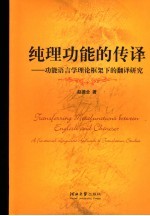
- 作 者:赵德全著
- 出 版 社:保定:河北大学出版社
- 出版年份:2007
- ISBN:7810971859
- 标注页数:202 页
- PDF页数:223 页
请阅读订购服务说明与试读!
订购服务说明
1、本站所有的书默认都是PDF格式,该格式图书只能阅读和打印,不能再次编辑。
2、除分上下册或者多册的情况下,一般PDF页数一定要大于标注页数才建议下单购买。【本资源223 ≥202页】
图书下载及付费说明
1、所有的电子图书为PDF格式,支持电脑、手机、平板等各类电子设备阅读;可以任意拷贝文件到不同的阅读设备里进行阅读。
2、电子图书在提交订单后一般半小时内处理完成,最晚48小时内处理完成。(非工作日购买会延迟)
3、所有的电子图书都是原书直接扫描方式制作而成。
Chapter 1 Introduction 1
1.1 Introduction 1
1.2 Theoretical bases 3
1.2.1 Systemic analysis on attempted texts 3
1.2.2 Traditional Chinese translation theory 4
1.2.3 Contemporary western theories 6
1.3 The statement of the problems 7
1.4 The goals of the study 8
1.5 The scope of the study 10
1.6 Procedures 10
1.7 The outline of the study 11
Chapter 2 Faithfulness and Equivalence 14
2.1 Introduction 14
2.2 Faithfulness 15
2.2.1 The early concept of faithfulness in translation 15
2.2.2 Xuan Zang's faithfulness 16
2.2.3 Translation practice following the Tang dynasty 18
2.2.4 Yan Fu's faithfulness 19
2.2.5 Translation theory in present China 23
2.3 Equivalence 26
2.3.1 Nida's concept of equivalence 26
2.3.2 Catford and translation equivalence 29
2.4 Systemic view on translation and equivalence 33
2.5 Summary 38
Chapter 3 Transferring Ideational Function 40
3.1 Introduction 40
3.2 Systemic functional perspective on languages 42
3.3 Metafunctions 42
3.4 Ideational functions and transitivity system 44
3.5 Preservation of ideational components 57
3.6 Ideational components in poetry 64
3.7 Shifts in translation 68
3.7.1 Order shifts 69
3.7.2 Rank shift 70
3.7.3 Structure shift 72
3.8 Summary 75
Chapter 4 Transferring Interpersonal Function 77
4.1 Introduction 77
4.2 Interpersonal function of language 79
4.2.1 Speech functions 80
4.2.2 Constituents of the mood 82
4.2.3 Constituents of the residue 83
4.2.4 Modality 86
4.3 Transferring interpersonal function 88
4.3.1 The interpersonal meaning in the ideational content 88
4.3.2 Prioritized interpersonal function 90
4.3.3 Transferring interpersonal function in opera translation 93
4.3.4 Transferring interpersonal function in novel translation 105
4.4 The balance between ideational function and interpersonal function 114
4.5 Summary 116
Chapter 5 Transferring Textual Function 118
5.1 Introduction 118
5.2 Textual function of languages 119
5.2.1 Theme and rheme 120
5.2.2 Given and new 124
5.2.3 Cohesion and coherence 126
5.3 Transferring textual function 128
5.3.1 Theme-rheme system in translation 129
5.3.2 Information system in translation 134
5.3.3 Focus-shifts in translation 140
5.3.4 Cohesion and coherence in translation 149
5.4 Summary 159
Chapter 6 Literal Translation and Free Translation 161
6.1 Introduction 161
6.2 Traditional concepts of literal and free translation 162
6.2.1 Early concepts of literal and free translation in China 162
6.2.2 Xuan Zang's strategy in Buddhist translation 164
6.2.3 Yan Fu—a practitioner of free translation 166
6.2.4 Lu Xu's adherence to the literal translation 168
6.2.5 Concepts of literal translation and free translation in western countries 169
6.2.6 Xu Yuanchong's summary on literal and free translation 171
6.3 Functional perspective on literal and free translation 173
6.3.1 Nature of literal and free translation 173
6.3.2 Automatization and de-automatization 177
6.3.3 Transferring ideational function:from literal translation to free translation 180
6.4 Summary 185
Chapter 7 Conclusion 187
7.1 Introduction 187
7.2 Questions involved 188
7.3 Major findings 189
7.4 Implications and applications 192
7.5 Limitations and suggestions 193
Bibbiography 195
